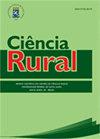Epizootiology of canine distemper in naturally infected dogs in Goiânia, Brazil
IF 0.9
4区 农林科学
Q3 AGRONOMY
引用次数: 0
Abstract
ABSTRACT: Although the epizootiological profile of canine distemper in Goiânia is unknown, there is clinical evidence for a high incidence of canine distemper virus (CDV) infection among dogs. Therefore, this study determined the epizootiological characteristics of canine distemper in naturally infected dogs. Data of 46 dogs that tested positive for the CDV based on immunochromatography or reverse transcription-polymerase chain reaction were collected. Data on the sex, breed, age, and vaccination status were obtained from these dogs, and extraneural and neural sign analyses were performed. Although, the infected dogs belonged to both sexes, different breeds, and different age groups, a greater proportion of cases were seen in adults (1-6 years), undefined breeds, and unvaccinated dogs. Among the CDV-positive dogs, 10.87% had been vaccinated. In addition, 4.35% showed neural signs, 8.69% showed extraneural signs, and 86.96% showed both. High lethality was observed, with viral antigen and/or DNA detected in 82.61% dead dogs. Only 8.70% of the total CDV-infected dogs remained alive at the time of their assessment.巴西goi尼亚自然感染犬犬瘟热的流行病学研究
摘要:尽管狼疮犬犬瘟热的流行病学特征尚不清楚,但有临床证据表明犬瘟热病毒(CDV)感染在犬类中的发病率很高。因此,本研究确定了自然感染犬犬瘟热的流行病学特征。收集了46只经免疫层析或逆转录聚合酶链反应检测为CDV阳性的狗的数据。从这些狗身上获得了性别、品种、年龄和疫苗接种状况的数据,并进行了神经外和神经体征分析。虽然受感染的狗属于两性、不同品种和不同年龄组,但更大比例的病例发生在成人(1-6岁)、未确定品种和未接种疫苗的狗身上。接种疫苗的犬只比例为10.87%。4.35%表现为神经征象,8.69%表现为神经外征象,86.96%表现为两者兼而有之。死亡率高,82.61%的死犬检出病毒抗原和/或DNA。在接受评估时,感染了cdc的犬只中只有8.70%存活。
本文章由计算机程序翻译,如有差异,请以英文原文为准。
求助全文
约1分钟内获得全文
求助全文
来源期刊

Ciencia Rural
AGRONOMY-
CiteScore
1.70
自引率
0.00%
发文量
233
审稿时长
2-4 weeks
期刊介绍:
The purpose of Ciência Rural is to publish the results of original research, note and reviews which contribute significantly to knowledge in Agricultural Sciences. Preference will be given to original articles that develop news concepts or experimental approaches and are not merely repositories of scientific data. The decison of acceptance for publication lies with the Editors and is based on the recommendations of Editorial Comission, Area Committee and/ or ad hoc reviewers. The editors and reviewers are external to the institution.
 求助内容:
求助内容: 应助结果提醒方式:
应助结果提醒方式:


